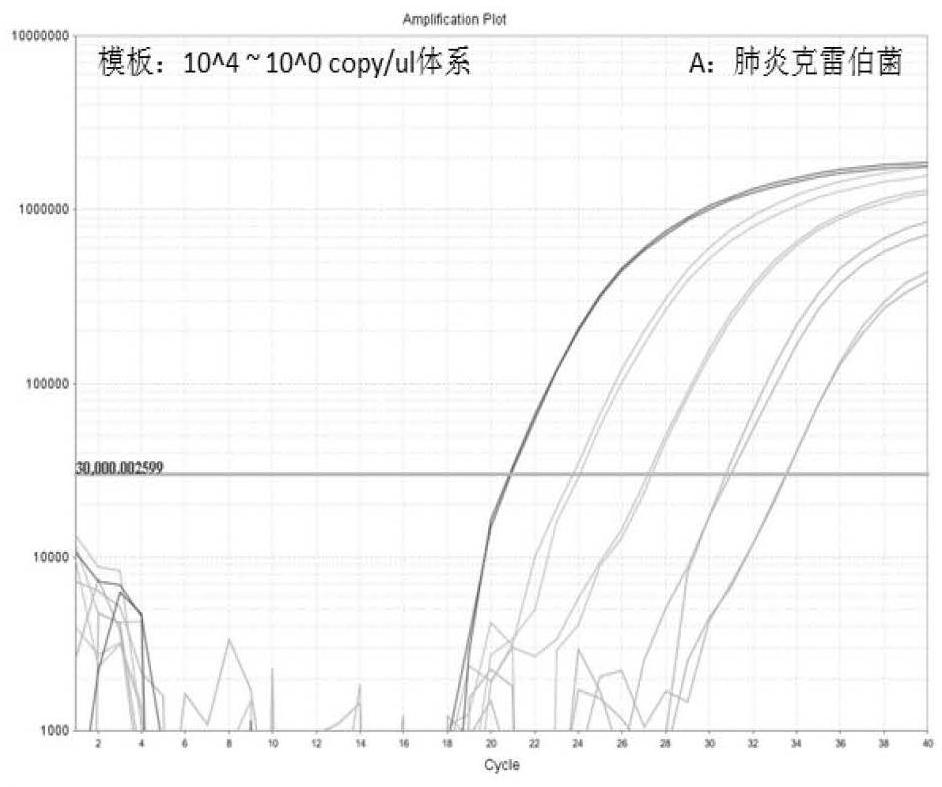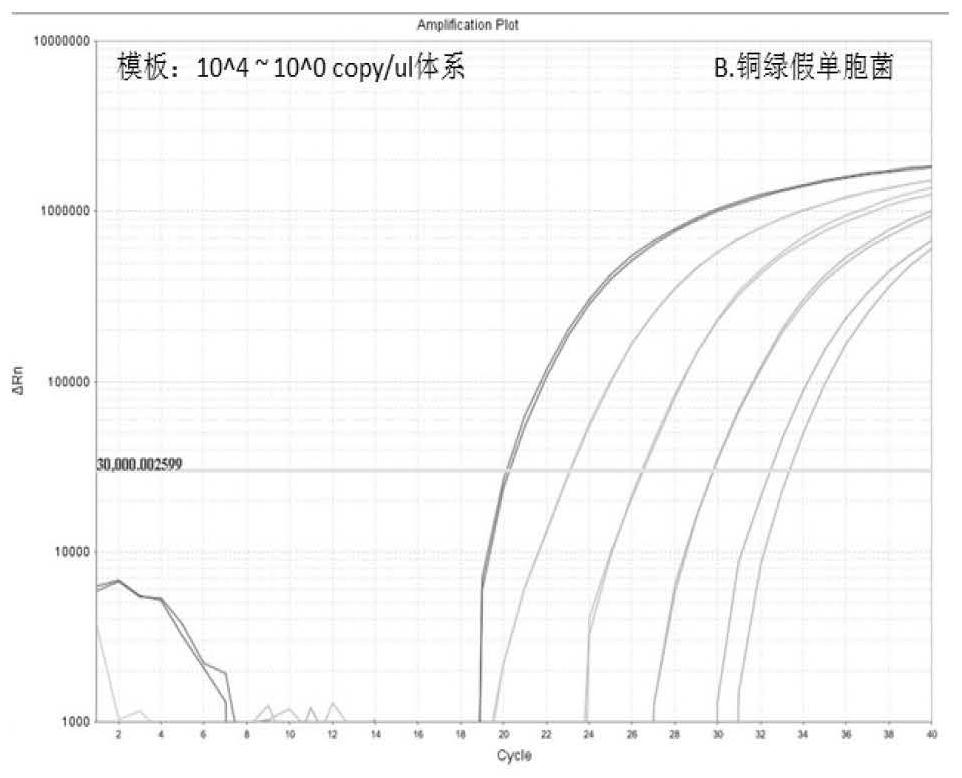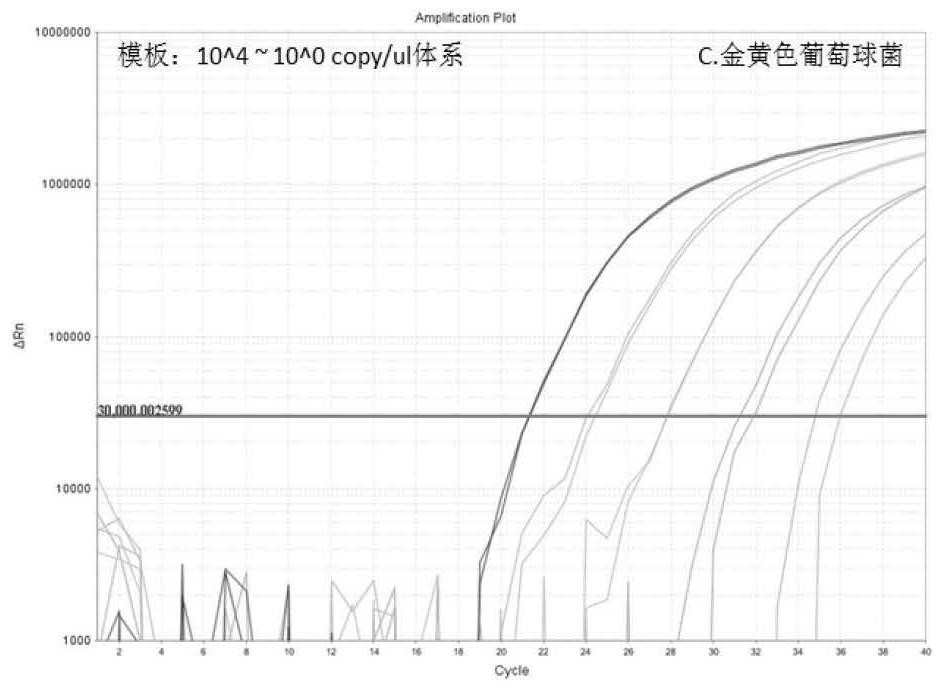Multiplex fluorescent quantitative probe method PCR (Polymerase Chain Reaction) kit for detecting urethral pathogen infection
A kit and pathogen technology, which is applied in the field of multiplex fluorescence quantitative PCR kits for detecting urinary tract pathogen infection, can solve the problems of unsuitable materials, complicated operation, lack of specificity, etc.
- Summary
- Abstract
- Description
- Claims
- Application Information
AI Technical Summary
Problems solved by technology
Method used
Image
Examples
Embodiment 1
[0161] Embodiment 1 single-fold fluorescent quantitative PCR detects pathogen of genitourinary tract infection
[0162] 1.1 Preparation of fluorescent quantitative PCR primer set
[0163] Get the DNA nucleic acid sequence of human endogenous control human actin gene beta-actin from GenBank and 12 kinds of DNA pathogens including Klebsiella pneumoniae, Pseudomonas aeruginosa, Staphylococcus aureus, Enterococcus faecalis, Proteus mirabilis , Escherichia coli, Acinetobacter baumannii, Ureaplasma parvum, Candida albicans, Mycoplasma genitalium, Chlamydia trachomatis, and Neisseria gonorrhoeae, and performed homology comparison analysis to determine the conserved sequence regions of various targets , and then select the appropriate sequence in the conserved region, and use Primer Primer 3.0 software to design 13 pairs of specific pre-amplification primer pairs and 13 sets of fluorescent quantitative PCR primer sets.
[0164] The primers and probes of human endogenous controls and ...
Embodiment 2
[0172] Example 2 Optimized Multiplex Fluorescent Quantitative PCR Detection of Urogenital Tract Infection Pathogens
[0173] 2.1 DNA reference preparation
[0174] With each plasmid reference 5×10 5 Copy / μl configures multiple (every 3 DNA pathogens and 1 internal reference) control plasmid mixed reference products for the mother solution, wherein the concentration of each plasmid is 5×10 4 copies / μl, 5×10 3 copies / μl, 5×10 2 copies / μl, 5×10 1 copies / μl and 5×10 0 copy / μl, single pathogen detection reaction system: take 4 μl amplicon as template (template concentration is 1×10 4 copies / μl, 1×10 3 copies / μl, 1×10 2 copies / μl, 1×10 1 copies / μl and 1×10 0 copies / μl).
[0175] 2.2 Multiplex fluorescent quantitative PCR detection of DNA pathogens
[0176] According to the classification of nosocomial acquired pathogens, intestinal flora-like pathogens, reproductive tract infectious pathogens and other pathogens, 12 pathogens were grouped, and multiplex (quadruple) fluore...
Embodiment 3
[0185] Example 3 Optimized Multiplex Fluorescent Quantitative PCR Detection Sensitivity Experiment of Urinary Infection DNA Pathogens
[0186] In order to evaluate the detection sensitivity of the quadruple fluorescent quantitative PCR (Taqman method), the concentration was 5 × 10 5 The copy / μl pathogen plasmid is the mother solution, and four groups of mixed reference products are prepared according to Table 1. Each group contains 3 kinds of pathogens and internal reference, and the concentration of each pathogen plasmid is 5×10 4 copy / μl, diluted with TE buffer to the following gradient concentration, as a sensitivity reference:
[0187] 5000 copies / μl sensitivity reference;
[0188] 500 copies / μl sensitivity reference;
[0189] 50 copies / μl sensitivity reference;
[0190] 5 copies / μl sensitivity reference.
[0191] Results: The detected Ct values are shown in Table 3.
[0192] Table 3 Target pathogen sensitivity detection results
[0193]
[0194]It can be seen f...
PUM
 Login to View More
Login to View More Abstract
Description
Claims
Application Information
 Login to View More
Login to View More - R&D
- Intellectual Property
- Life Sciences
- Materials
- Tech Scout
- Unparalleled Data Quality
- Higher Quality Content
- 60% Fewer Hallucinations
Browse by: Latest US Patents, China's latest patents, Technical Efficacy Thesaurus, Application Domain, Technology Topic, Popular Technical Reports.
© 2025 PatSnap. All rights reserved.Legal|Privacy policy|Modern Slavery Act Transparency Statement|Sitemap|About US| Contact US: help@patsnap.com



